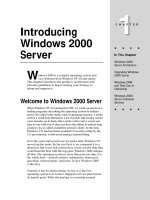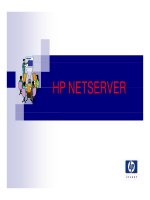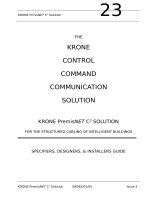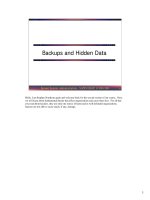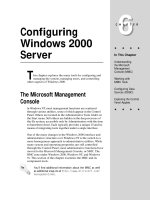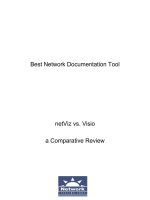Tài liệu Multiple-Input-Multiple- Output (MIMO) Systems doc
Bạn đang xem bản rút gọn của tài liệu. Xem và tải ngay bản đầy đủ của tài liệu tại đây (444.63 KB, 34 trang )
Multiple-Input-Multiple-
Output (MIMO) Systems
Basic principles, Algorithms and
Networking Applications
HARISH GANAPATHY
Topics
Motivations for the development of MIMO systems
MIMO System Model and Capacity Studies
Design Criterion for MIMO Systems (Diversity Vs
Spatial Multiplexing)
Some actual architectures based on these criterion
MIMO-OFDM
Networking Applications: MAC protocol for MIMO
PHY layer
Conclusions
Aspirations
High data rate wireless communications links with transmission
rates nearing 1 Gigabit/second (will quantify a “bit” shortly)
Provide high speed links that still offer good Quality of Service
(QoS) (will be quantified mathematically)
Aspirations (Mathematical) of a
System Designer
High data rate
Quality
Achieve
“Channel Capacity (C)”
Minimize Probability of Error (P
e
)
Real-life Issues
Minimize complexity/cost of
implementation of proposed
System
Minimize transmission power
required (translates into SNR)
Minimize Bandwidth (frequency
spectrum) Used
Antenna Configurations
Single-Input-Single-Output (SISO) antenna system
Theoretically, the 1Gbps barrier can be achieved using this configuration if you are allowed to
use much power and as much BW as you so please!
Extensive research has been done on SISO under power and BW constraints. A combination
a smart modulation, coding and multiplexing techniques have yielded good results but far
from the 1Gbps barrier
channel
User data stream
User data stream
MIMO Antenna Configuration
User data stream
User data stream
.
.
1
2
M
T
.
.
.
1
2
M
R
.
.
.
.
.
channel
Use multiple transmit and multiple receive antennas for a
single user
Now this system promises enormous data rates!
Data Units
Will use the following terms loosely and
interchangeably,
Bits (lowest level): +1 and -1
Symbols (intermediate): A group of bits
Packets (highest level): Lots and lots of
symbols
Shannon’s Capacity (C)
Given a unit of BW (Hz), the max error-free transmission rate is
C = log
2
(1+SNR) bits/s/Hz
Define
R: data rate (bits/symbol)
R
S
: symbol rate (symbols/second)
w: allotted BW (Hz)
Spectral Efficiency is defined as the number of bits transmitted per
second per Hz
R x R
S
bits/s/Hz
W
As a result of filtering/signal reconstruction requirements, R
S
≤ W.
Hence Spectral Efficiency = R if R
S
= W
If I transmit data at a rate of R ≤ C, I can achieve an arbitrarily low P
e
Spectral Efficiency
Spectral efficiencies of some
widely used modulation
schemes
The Whole point: Given an acceptable P
e
, realistic power and BW
limits, MIMO Systems using smart modulation schemes provide
much higher spectral efficiencies than traditional SISO
Scheme b/s/Hz
BPSK 1
QPSK 2
16-QAM 4
64-QAM 6
MIMO System Model
y = Hs + n
User data stream
.
.
User data stream
.
.
.
.
Channel
Matrix H
s
1
s
2
s
M
s
y
1
y
2
y
M
y
Transmitted vector Received vector
.
.
h
11
h
12
Where H =
h
11
h
21
…… h
M1
h
12
h
22
…… h
M2
h
1M
h
2M
…… h
MM
. . …… .
M
T
M
R
h
ij
is a Complex Gaussian
random variable that models
fading gain between the ith
transmit and jth receive
antenna
Types of Channels
Fading Channels
Fading refers to changes in signal amplitude and phase caused
by the channel as it makes its way to the receiver
Define T
spread
to be the time at which the last reflection arrives
and T
sym
to be the symbol time period
Time-spread of signal
Frequency-selective
Frequency-flat
T
sym
T
spread
time
freq
1/T
sym
Occurs for wideband signals (small T
sym
)
TOUGH TO DEAL IT!
T
sym
T
spread
time
freq
1/T
sym
Occurs for narrowband signals (large T
sym
)
EASIER! Fading gain is complex Gaussian
Multipaths NOT resolvable
Channel Matrix H
In addition, assume slow fading
MIMO Channel Response
Taking into account slow fading, the MIMO channel impulse response is constructed as,
Time-spread
Channel Time-variance
Because of flat fading, it becomes,
a and b are transmit and
receive array factor vectors
respectively. S is the
complex gain that is
dependant on direction and
delay. g(t) is the transmit
and receive pulse shaping
impulse response
•
With suitable choices of array geometry and antenna element patterns,
H( ) = H which is an M
R
x M
T
matrix with complex Gaussian i. i. d random variables
•
Accurate for NLOS rich-scattering environments, with sufficient antenna spacing at
transmitter and receiver with all elements identically polarized
Capacity of MIMO Channels
y = Hs + n
Let the transmitted vector s be a random vector to be very general and n is normalized
noise. Let the total transmitted power available per symbol period be P. Then,
C = log
2
(I
M
+ HQH
H
) b/s/Hz
where Q = E{ss
H
} and trace(Q) < P according to our power constraint
Consider specific case when we have users transmitting at equal power over the channel
and the users are uncorrelated (no feedback available). Then,
C
EP
= log
2
[I
M
+ (P/M
T
)HH
H
] b/s/Hz
Telatar showed that this is the optimal choice for blind transmission
Foschini and Telatar both demonstrated that as M
T
and M
R
grow,
C
EP
= min (M
T
,M
R
) log
2
(P/M
T
) + constant b/s/Hz
Note: When feedback is available, the Waterfilling solution is yields maximum capacity but converges to equal power capacity at
high SNRs
Capacity (contd)
The capacity expression presented was over one realization of the channel.
Capacity is a random variable and has to be averaged over infinite realizations
to obtain the true ergodic capacity. Outage capacity is another metric that is
used to capture this
So MIMO promises enormous rates theoretically! Can we exploit this
practically?
MIMO Design Criterion
MIMO Systems can provide two types of gain
Spatial Multiplexing Gain Diversity Gain
•
Maximize transmission rate
(optimistic approach)
•
Use rich scattering/fading to
your advantage
•
Minimize P
e
(conservative
approach)
•
Go for Reliability / QoS etc
•
Combat fading
System designs are based on trying to achieve either goal or a little of both
If only I could have both! As expected, there is a tradeoff
Diversity
Each pair of transmit-receive antennas provides a signal path
from transmitter to receiver. By sending the SAME information
through different paths, multiple independently-faded replicas
of the data symbol can be obtained at the receiver end. Hence,
more reliable reception is achieved
A diversity gain d implies that in the high SNR region, my P
e
decays at a rate of 1/SNR
d
as opposed to 1/SNR for a SISO
system
The maximal diversity gain d
max
is the total number of
independent signal paths that exist between the transmitter
and receiver
For an (M
R
,M
T
) system, the total number of signal paths is M
R
M
T
1 ≤ d
≤ d
max
= M
R
M
T
The higher my diversity gain, the lower my P
e
Spatial Multiplexing
y = Hs + n y’ = Ds’ + n’ (through SVD on H)
where D is a diagonal matrix that contains the eigenvalues of HH
H
Viewing the MIMO received vector in a different but equivalent
way,
C
EP
= log
2
[I
M
+ (P/M
T
)DD
H
] = log
2
[1 + (P/M
T
)ג
i
] b/s/Hz
Equivalent form tells us that an (M
T
,M
R
) MIMO channel opens up
m = min (M
T
,M
R
) independent SISO channels between the
transmitter and the receiver
So, intuitively, I can send a maximum of m different information
symbols over the channel at any given time
∑
=
m
i 1
Practical System
Redundancy in time
Coding rate = r
c
Space- time redundancy over
T symbol periods
Spatial multiplexing gain = r
s
1
2
M
T
Channel
coding
Symbol
mapping
Space-
Time
Coding
.
.
R bits/symbol
r
s
: number of different
symbols N transmitted
in T symbol periods
r
s
= N/T
Spectral efficiency = (R*r
c
info bits/symbol)(r
s
)(R
s
symbols/sec)
w
= Rr
c
r
s
bits/s/Hz assuming R
s
= w
r
s
is the parameter that we are concerned about: 0 ≤ r
s
≤ M
T
** If r
s
= M
T
, we are in spatial multiplexing mode (max
transmission rate)
**If r
s
≤ 1, we are in diversity mode
Non-redundant
portion of symbols
V-BLAST – Spatial Multiplexing
(Vertical Bell Labs Layered Space-Time Architecture)
This is the only architecture that goes all out for maximum rate. Hope the
channel helps me out by ‘splitting’ my info streams!
.
.
s
1
s
2
s
M
s
User data
stream
.
.
User data
stream
.
.
y
1
y
2
y
M
y
.
.
H
V-BLAST
Processing
Split data into M
T
streams maps to symbols send
Assume receiver knows H
Uses old technique of ordered successive cancellation to recover signals
Sensitive to estimation errors in H
r
s
= M
T
because in one symbol period, you are sending M
T
different symbols
M
T
≤ M
R
V-BLAST
(Experimental Results)
The prototype in an indoor environment was operated at a carrier frequency of
1.9 GHz, and a symbol rate of 24.3 ksymbols/sec, in a bandwidth of 30 kHz with
M
T
= 8 and M
R
= 12
Results shown on Block-Error-Rate Vs average SNR (at one received antenna
element); Block = 100 symbols ; 20 symbols for training
•
Each of the eight substreams utilized uncoded
16-QAM, i.e. 4 b/symb/trans
•
Spec eff = (8 xmtr) ( 4 b/sym/xmtr )(24.3 ksym/s)
30 kHz
= 25. 9 bps/Hz
In 30 kHz of bandwidth, I can push across 621Kbps of data!! Wireless
spectral efficiencies of this magnitude are unprecedented, and are
furthermore unattainable using traditional techniques
Alternate Receivers
Can replace OSUC by other front-ends; MMSE, SUC,
ML for instance
OSUC
ML
D-BLAST – a little of both
(Diagonal Bell Labs Layered Space-Time Architecture)
In D-BLAST, the input data stream is divided into sub streams which
are coded, each of which is transmitted on different antennas time
slots in a diagonal fashion
For example, in a (2,2) system
•
receiver first estimates x
2
(1)
and then
estimates x
1
(1)
by treating x
2
(1)
as
interference and nulling it out
•
The estimates of x
2
(1)
and x
1
(1)
are fed to a
joint decoder to decode the first substream
•
After decoding the first substream, the receiver cancels
the contribution of this substream from the received signals
and starts to decode the next substream, etc.
•
Here, an overhead is required to start the detection process;
corresponding to the 0 symbol in the above example
•
Receiver complexity high
M
T
≤ M
R
Alamouti’s Scheme - Diversity
Transmission/reception scheme easy to implement
Space diversity because of antenna transmission. Time diversity
because of transmission over 2 symbol periods
Consider (2, M
R
) system
Receiver uses combining and ML detection
r
s
= 1
V-BLAST SUC
Alamouti
•
If you are working with a (2,2)
system, stick with Alamouti!
•
Widely used scheme: CDMA
2000, WCDMA and IEEE 802.16-
2004 OFDM-256
Comparisons
Scheme Spectral
Efficiency
P
e
Implementation
Complexity
V-BLAST HIGH HIGH LOW
D-BLAST MODERATE MODERATE HIGH
ALAMOUTI LOW LOW LOW
